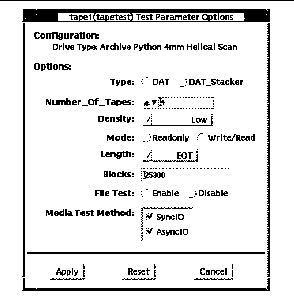tapetest Options
tapetest supports 4-mm, 8-mm, DLT, 1/4-inch cartridge, and 1/2-inch front-load tape drive testing. The options available for each of the tape devices differ slightly. An example of the option pop-up menu for a device is shown in Figure 40-1.
The Async I/O subtest uses the asynchronous read and write feature of the Solaris tape driver to exercise tape drives. In read-only mode the test sends a maximum of four asynchronous read packets, each with a random size and a random offset, to the tape drive. The test then waits for all outstanding I/O activity to complete before issuing another round of packets. This process continues until the whole area being tested has been covered. In read-write mode, one write packet is issued for every four read packets to ensure a spot check of the write operation. The area of the tape to be tested is written to first in order for the test to work correctly. This test is only supported under Solaris 2.6, Solaris 7 and compatible releases.
Figure 40-1 tapetest Option Menu (4-mm tape drives)

Note -
This test does not immediately stop after being disabled.
Figure 40-1 shows an example of the options menu for a 4-mm tape drive.
Note -
The option menus for the 1/4-inch, 1/2-inch, DLT, and 8-mm tape drives differ slightly from Figure 40-1.
Table 40-1 tapetest Options
|
tapetest Options |
Description |
|---|---|
|
Type |
Normal tape drive or tape library (stacker). |
|
# of Tapes |
The number of tapes in the tape library. tapetest registers a single tape library pass only after all tapes in the library pass. |
|
Density |
The following settings are available for most tape drives: -Low: Tests the l tape device. -Medium: Tests the m tape device. -Compression: Tests the c tape device. -All: Tests the l, m, and c tape devices. For half-inch tape drives, the available settings are 800, 1600, and 6250 BPI (blocks per inch). For certain QIC drives select QIC-11 (1-byte block ID) mode, QIC-24 (4-byte block ID) mode, or both. |
|
Mode |
If you enable Write/Read mode, the test first writes to the tape and then reads it back to compare. If you enable Read_Only mode, the test assumes the tape has been properly written and merely reads and compares. This mode is useful to check proper head alignment. |
|
Length |
The amount of the tape to be tested. The choices are: -EOT: The default; tests to the entire tape. -Long: The SCSI tape tests 70,000 blocks of the tape. -Short: Only the first 1000 blocks are tested. -Specified: You must type the number of blocks to be tested in the # of blocks field. |
|
# of Blocks |
If you select Specified under the Length option, you must type the number of blocks you want to test. |
|
Blocksize |
Block size specification. This option is only available for Tandberg QIC tape drives. There are two possible values; 512-bytes for use with older tape media that have transfer size restrictions, or 64-kbytes for use with current, high-capacity tape media. |
|
File Test |
The tape file test sequence is as follows: -Writes three files -Rewinds -Reads part of the first file -Forward spaces to the start of the second file -Reads the second file -Forward spaces to the start of the third file -Tries to read to the end of that file for SCSI tapes only, the tape file test tries to backspace to the start of the second file and read it |
|
Retension |
When enable is selected, the program retensions the tape. |
|
Media Test Method |
Sync I/O: tapetest reads and or writes the number of blocks selected in Length. Async I/O: tapetest makes four asynchronous read requests to the tape drive. If read and write testing is selected, one asynchronous write request is also sent. The test continues after completing the requests. Note - When testing Tandberg QIC drives, Async I/O testing is restricted to read-only due to asynchronous behavior differences with other tape drives. |
- © 2010, Oracle Corporation and/or its affiliates
